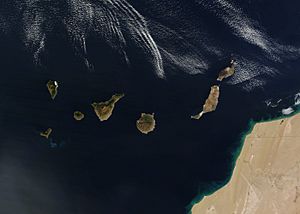Canary hotspot facts for kids
The Canary hotspot is a special place under the Canary Islands where a lot of volcanic activity happens. These islands are located off the northwest coast of Africa. Scientists think this activity comes from a deep, hot spot in the Earth's mantle that started about 70 million years ago. The most recent eruptions in this area were underwater near El Hierro and on land at Cumbre Vieja.
Contents
How the Canary Islands Formed
Scientists have a big idea about how the Canary Islands formed. It's called the "deep mantle plume hypothesis." This idea suggests that about 60 million years ago, the Canary Islands area was above a pool of hot, melted rock (magma). This magma came from a huge area called the Central Atlantic Magmatic Province (CAMP).
The CAMP was very active and spread over a massive area, eventually helping to create the Mid-Atlantic Ridge. The African Plate, which the islands sit on, slowly moved over this hot spot in the Earth's mantle. Imagine a conveyor belt moving land over a fixed heat source! However, some scientists question this idea because there were times when no volcanoes erupted for millions of years between islands.
Recent Volcano Eruptions
The Canary Islands are still volcanically active. Here are two recent eruptions:
El Hierro Eruption
From July to September 2011, the Canary island of El Hierro experienced thousands of small tremors. Scientists believed these were caused by magma moving beneath the island. People worried about a volcano erupting.
An eruption finally began on October 10, 2011. It happened about 1 kilometer south of the island, from a crack (called a fissure) on the ocean floor. The eruptions continued until March 2012.
Cumbre Vieja Eruption
Before the Cumbre Vieja eruption on the island of La Palma on September 20, 2021, over 25,000 earthquakes were recorded. These started on September 10. The Cumbre Vieja volcano has been very active since the 1971 Teneguía eruption. For example, from October 2017 until the 2021 eruption, there were nine earthquake swarms.
Because of the Cumbre Vieja eruption, more than 5,000 people living on the island had to leave their homes. This helped keep people safe and greatly reduced injuries. However, over 1,300 homes and 1,500 other buildings were damaged. The continuous flow of magma stopped repair efforts for weeks. As of 2023, La Palma is still working to rebuild its roads and buildings.
See also
 In Spanish: Punto caliente de Canarias para niños
In Spanish: Punto caliente de Canarias para niños
- Mantle plume
- 2011–12 El Hierro eruption
- 2021 Cumbre Vieja volcanic eruption
- Geology of the Canary Islands
Images for kids



